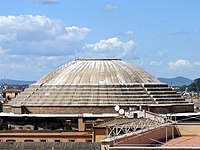
Photo from wikipedia
Abstract Strength and permeability assessment of concrete structures, such as open channels are considered to be of great importance. Aggregates make up the major part of the concrete mix. So,… Click to show full abstract
Abstract Strength and permeability assessment of concrete structures, such as open channels are considered to be of great importance. Aggregates make up the major part of the concrete mix. So, their effect on concrete specifications should be investigated. For this reason, this paper presents the strength and permeability results of the 28-day concrete specimens made of granite, andesite, siliceous, lime, marble and tuff aggregates. In this investigation, “Cylindrical chamber” and “Twist-off” methods were used to assess the permeability and surface strength, respectively. The obtained results illustrate that rock stone has a higher strength compared with the concrete specimens made of the aggregates of the same rock stone and there is a direct linear relationship between the compressive strength of the rock stone and concrete specimens and their surface strength obtained using the “twist-off” method. Furthermore, a significant correlation was revealed between the strength and density of the saturated surface dry aggregates on one part and the strength and the penetrated water volume into the concrete specimens on the other part. The results convey that, as the water absorption of the aggregates and the permeability of the rock decrease, the strength of the concrete specimens made of the same rock stone increases, while their permeability decreases. Furthermore, it was observed that, as the strength of the concrete specimens increases, their permeability decreases. The specimens, revealing higher strength and lower permeability were made of granite, andesite, siliceous, lime, marble and tuff aggregates, respectively.
Journal Title: Journal of building engineering
Year Published: 2020
Link to full text (if available)
Share on Social Media: Sign Up to like & get
recommendations!